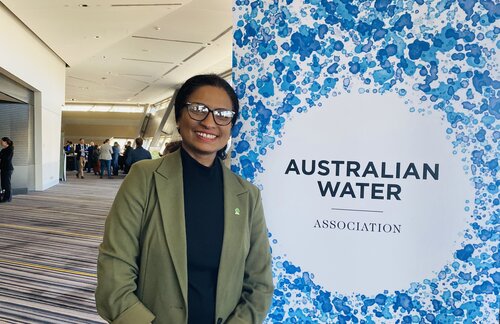
A South Australian startup is providing water-sensitive urban design solutions for local councils with a system designed to capture stormwater runoff using recycled wheelie bins.

A water sector conference in South Australia last week heard the company’s Treenet inlets replicate natural watershed functions to turn cities into ‘green sponges’, rather than directing precious water away from urban areas via traditional stormwater systems.
Dr Harsha Sapdhare, research and development manager with Space Down Under, says the Treenet system can be used alongside standard kerbside stormwater drains.
The system works by catching runoff as it flows down gutters in a shallow bowl, which works like a vortex to wash out debris and direct water into the inlet.
The inlet circulates the water into an infiltration zone made out of recycled wheelie bins, and it’s then dispersed over time into the surrounding soil.
Improved tree growth
A 2019 study found 65 per cent more growth over four years in trees using the system than in controls using other methods, Dr Sapdhare said.

“It successfully provides sustainable, passive irrigation to street trees,” she told Government News after her presentation to the Australian Water Association State Conference in SA on Friday.
“It’s the idea of keeping water where it falls and redirecting it to the soil where trees can absorb it. All our existing systems as designed to take water away from the city but with this we are talking about shifting the flows.
“If a council uses the system, they only need to water a new tree just for one year to establish roots, and after the second year there is no need to water these plants again.”
The way the water is distributed in the soil also encourages tree roots to grow in a direction that minimises infrastructure damage to pavements and roads, she adds.
Thousands of litres of free water
City of Prospect is one council that is using water-sensitive urban design to promote the sustainable use of water, including Treenet inlets and permeable paving.
The City has installed over 80 inlet systems in its roadside verges, and says they capture more than 10,000 litres of free water for trees a year.
It also helps moderate urban heat island effects, with each inlet adding the equivalent of a 5kW evaporative air conditioning unit to the street based on extra cooling provided by the trees.
In addition, council has installed permeable paving that allows water to travel through a gravel base to the soil beneath.
Partnering with local government
Space Down Under has partnered with councils across Adelaide, including Mitchum City Council, City of Unley, Port Adelaide and the Legatus Group of regional SA councils to test the system across a variety of catchment areas.
It has sold 25,000 units, including 16,000 in Melbourne, at a cost of between $300 and $400 per unit depending on the model. Once installed, the system is there for good.
The company is currently looking to collect data from more sites, Dr Sapdhare says.
“If councils have a strategic plan to develop the canopy to reduce carbon, how they can achieve that?” Dr Sapdhare says.
“This is the solution.”
Comment below to have your say on this story.
If you have a news story or tip-off, get in touch at editorial@governmentnews.com.au.
Sign up to the Government News newsletter
It’s good to see data that backs up the claim .
Most councils have increased canopy targets but are losing canopy in the private realm.
They also have street trees already within a metre of the kerb that could contribute most to canopy cover if given the water that goes past to pollute downstream aquatic environments.
Treenet pits offered by space down under are a good use of urban stormwater. For sustainable cities, any landholder increasing the imperviousness of the city should be required to offset stormwater impacts preferably on-site, but where this is impractical to pay council to do it in the public realm. Treenet pits are part of the solution. Increasing 24 hour detention storage by say 20 L per square metre of new impervious area would prevent increase in flood risk, as well as offset urban heating and greenspace loss where this is done to enhance greening of streets. Congratulations to Space Down Under for using recycled materials for environmental benefit and giving a distributed solution for development offsets.
Indeed a great innovative way towards net zero.
What a fantastic initiative and should be adopted whenever and wherever possible as a retrofit proposition – but – in new subdivisions where lot sizes are very small these days it should be mandated through the land development process to off set the fact that these lots cannot be planted with large canopy trees due to the minimum set back requirements for houses and the requirements for distances from side fences and back fences – if indeed there is any at all
Yes Roger, you captured the problem.
We have a planning system that creates Heat islands and to address the issue by reusing water to green the suburb is rendered impossible by this . So using this great Technology is not going to fix the issue in new suburbs in NSW but a change of planning policy can. With this type of clever thinking will help in other situations.